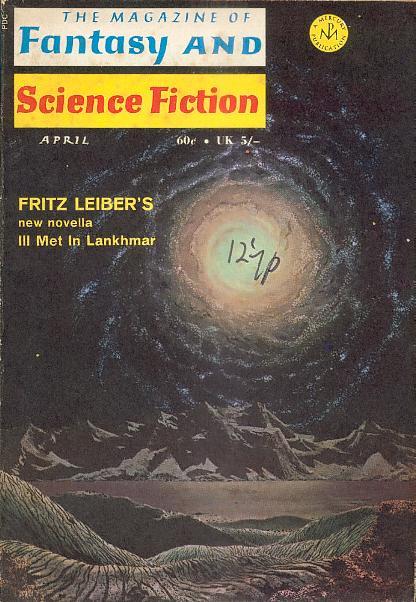(1) CHANGING OF THE GUARDIAN. Lisa Tuttle has taken the handoff from The Guardian’s SF/Fantasy reviewer Eric Brown who ended his fifteen-year run in January. Tuttle’s first genre round-up will appear in The Guardian’s books section on Saturday, February 13.
(2) MANDALORIAN ACTRESS OUT. Deadline reports “Gina Carano Off ‘The Mandalorian’ After Social Media Comments”. Their article quotes from the posts she made immediately following this excerpt:
In the wake of Gina Carano’s controversial social media posts, Lucasfilm has released a statement Wednesday night, with a spokesperson saying “Gina Carano is not currently employed by Lucasfilm and there are no plans for her to be in the future. Nevertheless, her social media posts denigrating people based on their cultural and religious identities are abhorrent and unacceptable.”
Carano played bounty hunter Cara Dune on the first two seasons Lucasfilm and Disney+’s The Mandalorian, and it looked like we’d be seeing more of her. It appears not….
(3) ROBORIGHTS. A film based on the short story “Dolly” by Elizabeth Bear is in development: “Apple TV+ Lands Hot Package ‘Dolly’ With Florence Pugh On Board To Star” at Deadline.
Following competitive bidding war, Apple Studios has landed Dolly, a new feature film with Academy Award-nominee Florence Pugh attached to star with Vanessa Taylor and Drew Pearce Penning the script. Insiders close to the project stress the project is not greenlit at this time as the script still needs to penned and a director still needs to be attached. Insiders go on to add that the package caught the interest of a total of four bidders that included multiple studios and another streamer with Apple TV+ emerging as the winner earlier this week.
The film is a sci-fi courtroom drama in which a robotic “companion doll” kills its owner and then shocks the world by claiming that she is not guilty and asking for a lawyer. The film, which is inspired by Elizabeth Bear’s short story of the same name, has elements of both classic courtroom drama and sci-fi….
(4) FOURTH COMING. In “The Four Types of Time Travel (And What They Say About Ourselves and the World Around Us)” at CrimeReads, Dan Frey looks at whether time travel novels have characters going forwards or backwards in time and whether they retrieve objects.
Time travel is a genre unto itself, one that spans sci-fi, mystery, fantasy, history and more. But there are distinct categories of time travel narratives, each with its own set of rules—and each with a different baked-in outlook.
Getting to a taxonomy of time travel stories, the first question is—who or what is actually time-traveling? Because while the first stories we think of involve spaceships and Deloreans, the oldest time travel stories are stories about…
1. SEEING THE FUTURE
In these stories, it is actually INFORMATION that travels through time. And this might be the most scientifically plausible form of time travel, one that is already happening all the time on the quantum level….
(5) WHAT MIGHT HAVE BEEN. Robert J. Sawyer tells Facebook readers that 26 years ago Ace Science Fiction thought they were going to land a contract with Lucasfilm to produce a trilogy of novels outlining the origins of the alien races from the Star Wars universe:
Ace editor Ginjer Buchanan approached me to write those books, and before the license was finalized I produced an 11,000-word outline and also the first 11,000 words of the manuscript of volume one. But the deal fell apart — yes, they’d get a Lucasfilm license, but, no, I couldn’t use any of the actual STAR WARS races, and so I walked away. Since I was never paid for the work, I posted the material on my website as fan fiction.
Sawyer mentioned this because the Yub Nub podcast episode “Hollywood Dinners and Alien Exodus”, which dropped today, discusses that project beginning at the 36:30 mark.
Sawyer reminds fans that the outline for the whole book is here: “Alien Exodus Outline”. And his opening chapters are here: “Alien Exodus Chapters”.

(6) THE WORDS OF SFF. In the February 6 Financial Times, book columnist Nilanjana Roy discusses the Historical Dictionary of Science Fiction website.
Skipping from ‘ecotopia’ (first used back in 1975) to ‘Frankenstein complex ‘(coined by Isaac Asimov in 1947 to describe the anxiety and distrust held by humans towards robots), a living history of science fiction began to take shape in my mind. The HDSF records language coined by eminent figures from the realms of literature and science, but also long-forgotten hacks who wrote stories for the pulps…
…The HDSF is full of surprises, even to an unabashed sf fan. Many entries are older than I imagined: ‘teleport’ might seem like a word dreamt up in the 1950s, for instance, but the first recorded instance comes from an 1878 mention in the Times Of India: ‘The teleport,.an apparatus by which men can be reduced to infinitessimal (sic) atoms, transmitted through the wire, and reproduced safe and sound on the other end!’ While “infodump” was first used in a 1978 conference on science.
(7) BE CAREFUL WHAT YOU WISH FOR. Someone who dismissed the Locus Recommended Reading List as “useless” was pointed at the “Tangent Online 2020 Recommended Reading List” which contains these introductory remarks by Dave Truesdale:
… Looking at short fiction over at least the past 10 years, a general observation can be made. It would appear that Woke Culture is as pervasive and cancerous as it has ever been for at least the past 10 years. The dearth of true originality when it comes to political or socially themed short fiction is becoming more and more apparent to those of us who have observed and studied the field for decades. Political Correctness has now infiltrated the field like a metastazing cancer, to the point where long time readers are beginning to voice complaints. The complaints arise not from what is published in the magazines or some of the original anthologies, but what is not being published. Identity Politics and the Cancel Culture have inserted themselves into the field to the extent that not only magazine fiction editors, but other areas of the SF field are bowing to intimidation and peer pressure to conform to the total obeisance the Woke doctrine demands….
(8) PRESENT AT THE CREATION. The documentary Marvel’s Behind the Mask premieres tomorrow on Disney+. Variety has an exclusive clip, and homes in on one topic — how the “Black Panther’s ‘Perfect’ Marvel Comic Book Launch Had One Major Flaw”.
When Marvel Comics first launched the character of Black Panther, it was in the July 1966 issue of “Fantastic Four.” As explained in this exclusive clip from the upcoming Disney Plus documentary “Marvel’s Behind the Mask,” premiering Feb. 12, the character of T’Challa, the King of Wakanda, was presented just like any other Marvel superhero — attention wasn’t paid to the color of his skin, but rather to the supreme quality of his abilities.
“The first Black superhero, Black Panther, comes out perfect,” says writer-director Reginald Hudlin, who wrote a run of Black Panther comics in the 2000s. “He’s this cool, elegant, handsome guy who’s just got it on lock.”
But as the clip also demonstrates, there’s one essential element of Black Panther that was glaringly incorrect: His skin is grey, not brown.
…Rather than shy away from its less than admirable history, the “Behind the Mask” filmmakers say Marvel’s executives were on board with a warts-and-all look at the company’s efforts with representation. “They were complete partners,” says Gary. “They accepted the fact that we were going to make some things uncomfortable.” The company even opened up its vault so the filmmakers could access the full range of its history.
“There were certain things that we needed to scan that weren’t part of the digital history, that were important to the storytelling,” says Simon. “We needed to get that older imagery out of the vault.”…
(9) NYT JAMES GUNN OBITUARY. The New York Times paid their respects today: “James Gunn, Prizewinning Science Fiction Author, Dies at 97”.
(10) MEMORY LANE.
- 1971 — Fifty years ago at Noreascon I, Fritz Leiber wins the Hugo for Best Novella with “Ill Met in Lankhmar”, one of his Fafhrd and The Grey Mouser tales. It was originally published in the April issue of Fantasy & Science Fiction. The other nominees were “The Thing in the Stone” by Clifford D. Simak, “The Region Between” by Harlan Ellison. “The World Outside” by Robert Silverberg and “Beastchild” by Dean R. Koontz.

(11) TODAY’S BIRTHDAYS.
[Compiled by Cat Eldridge and John Hertz.]
- Born February 11, 1898 – Leo Szilard. Vital in the Manhattan Project; first to connect thermodynamics and information theory; filed earliest known patent applications for the electron microscope, the linear accelerator, and the cyclotron (but did not build all these, nor publish in scientific journals, so credit went to others; Lawrence had the Nobel Prize for the cyclotron, Ruska for the electron microscope). Present when the first man-made self-sustaining nuclear chain reaction was achieved in the first nuclear reactor; shook Fermi’s hand. Credited with coining the term “breeder reactor”. Half a dozen short stories for us. To him is attributed “We are among you. We call ourselves Hungarians.” (Died 1964) [JH]
- Born February 11, 1910 — L. T. C. Rolt. English writer whose enthusiasm for heritage railways is writ large in his 1948 Sleep No More collection of supernatural horror stories which tend to be set in rural railways. (Simon R. Green may be influenced by him in his Ghost Finders series which often uses these railways as a setting.) Some of these stories were adapted as radio dramas. Sleep No More isavailable from the usual digital suspects. (Died 1974.) (CE)
- Born February 11, 1915 – Mabel Allan. Four novels, one shorter story for us; a hundred seventy books all told, some under other names; some in series e.g. a dozen about Drina Adams who at age 10 wants to be a ballerina and finally is. Here is the Mabel Project for reading MA’s books in chronological order. (Died 1998) [JH]
- Born February 11, 1920 – Daniel Galouye. (“Ga-lou-ey”) Navy pilot during World War II; journalist; New Orleans fan who developed a pro career. Half a dozen novels, five dozen shorter stories. Guest of Honor at Consolacon, DeepSouthCon 6. Interviewed in Speculation. Cordwainer Smith Rediscovery Award. (Died 1976) [JH]
- Born February 11, 1926 — Leslie Nielsen. I know the comic, bumbling fool who delighted generations of film goers. But his first starring role was as Commander John J. Adams in one of the finest SF films of all time Forbidden Planet. I am most decidedly not a fan of his later films but I think he’s brilliant here. (Died 2010.) (CE)
- Born February 11, 1939 — Jane Yolen, 82. She loves dark chocolate so I send her some from time to time. She wrote me into a novel as a character, an ethnomusicologist in One-Armed Queen to be precise in exchange for finding her a fairytale collection she wanted. Don’t remember now what it was other than it was very old and very rare. My favorite book by her is The Wild Hunt which she’s signing a copy for me now, and I love that she financed the production of Boiled of Lead’s Antler Dance which her son Adam Stemple was lead vocalist on. (CE)
- Born February 11, 1948 — Robert Reginald. He’s here because of two Phantom Detective novels he wrote late in his career which are most popcorn literature. (The Phantom Detective series started in 1936 so he used the Robert Wallace house name.) He has two series of some length, the Nova Europa Fantasy Saga and War of Two Worlds. Much of what he wrote is available from the usual digital sources. (Died 2013.) (CE)
- Born February 11, 1950 — Alain Bergeron, 70. He received an Aurora Award for Best Short Story for “Les Crabes de Vénus regardent le ciel” published In Solaris number 73, and a Sideways Award for Alternate History for “Le huitième registre” (translated in English as “The Eighth Register” by Howard Scott). (CE)
- Born February 11, 1953 — Wayne Hammond, 68. He’s married to fellow Tolkien scholar Christina Scull. Together they’ve done some of the finest work on him that’s been done including J. R. R. Tolkien: Artist and Illustrator, The Lord of the Rings: A Reader’s Companion, The Adventures of Tom Bombadil and Other Verses from the Red Book and The J. R. R. Tolkien Companion and Guide. (CE)
- Born February 11, 1965 – John Zeleznik, age 56. A dozen covers, a score of interiors. Here is Find Your Own Truth. Here is The Heart of Sparrill. Here is his Rifts Coloring Book. Here is a Magic: the Gathering card. Ten years in Spectrum anthologies. Website. [JH]
- Born February 11, 1970 – Reinhard Kleist, age 51. Half a dozen covers, as many interiors. Here is Asimov’s collection Azazel. Here is Das Böse kommt auf leisen Sohlen (German, “Evil comes on quiet feet” – more literally Sohlen are soles – tr. Bradbury’s Something Wicked This Way Comes). [JH]
- Born February 11, 1975 – Kathy McMillan, age 46. Two novels for us, four others (one got an Indies Award); eight resource books for educators, librarians, parents. ASL (American Sign Language) Interpreter. Website says Author & Language Geek. [JH]
(12) COMICS SECTION.
- Carpe Diem has a space exploration joke.
(13) UNFORGOTTEN LORE. Gene Luen Yang fills readers in “On the Connection Between Chinese Folktales and American Comic Book Heroes” at Literary Hub.
I first heard about the monkey king from my mom.
When I was a kid, my mother used to tell me Chinese folktales before bedtime. My mother is an immigrant. She was born in mainland China and eventually made her way to the United States for graduate school.
She told me those stories so that I wouldn’t forget the culture that she had left. Even though I hadn’t ever experienced that culture firsthand, she wanted me to remember it.
Of all her stories, my favorites by far were about Sun Wukong, the monkey king. Here was a monkey who was so good at kung fu that his fighting skills leveled up to superpowers. He could call a cloud down from the sky and ride it like a surfboard. He could change his shape into anything he wanted. He could grow and shrink with the slightest thought. And he could clone himself by plucking hairs from his head and then breathing on them. How cool was that?…
…Turns out, my mother was pretty faithful. As I read it, I realized that American superheroes hadn’t replaced Sun Wukong in my heart after all. Superman, Spider?Man, and Captain America were simply Western expressions of everything I loved about the monkey king….
(14) THE MILLENNIUM HAS ARRIVED. The thousandth book by a woman reviewed on James Nicoll Reviews: “Just Keep Listening”.
K.B. Spangler’s 2021 coming-of-age space opera The Blackwing War is the first book in her Deep Witches Trilogy. It is set in the same universe as Spangler’s 2017 Stoneskin .
Tembi Stoneskin was rescued from abject poverty when the Deep, the vast, enigmatic entity that facilitates transgalactic teleportation, took a shine to her. As long as the Deep retains its affection for Tembi, she will be an ageless Witch, stepping from world to world as it pleases her. There is little chance Tembi will alienate the Deep.
There is, however, every chance she will alienate her superiors in the Witch hierarchy. Youthful Tembi is that most dreaded of beings, an idealist….
(15) YOU DON’T HAVE TO DIAL M ANYMORE. In “The Rise of the Digital Gothic” on CrimeReads, Katie Lowe says many of today’s Gothic novelists are coming up with plots that involve apparitions or other supernatural phenomena coming out of characters’ smartphones.
…But for all that this new technology gives, there’s also the sense of our personal spaces—the physical homes we inhabit—seeming always invaded by others, both strangers and not. They wander through, startling us with questions as we brew our morning coffee; scanning our living rooms while we’re on Zoom; liking our family photos as we crawl into bed. Our daily lives are interrupted constantly by apparitions: by the voices and figures of people who simply are not there.
This is not, however, a state of being sprung entirely from the pandemic—nor is it unique to fiction. In her 2014 essay “Return of the Gothic: Digital Anxiety in the Domestic Sphere,” critic Melissa Gronlund observed similarities between recent work in the visual arts. She suggests that artists using “the Gothic tropes of the uncanny, the undead, and intrusions into the home” in their work are searching for “a way to wrestle with daunting, ongoing questions prompted by current technological shifts: How has the internet affected our sense of self? Our interaction with others? The structures of family and kinship?”
(16) MARS MERCH. The Smithsonian National Air and Space Museum told people on its mailing list that the limited edition Mars Perseverance merchandise collection will only be available until February 21. (Click for larger images.)
(17) MR. SCOTT’S SECRET STUFF. Say, we just mentioned this substance the other day: “The Science Behind Transparent Aluminum on ‘Star Trek’” at Heavy.
… Forbes reports that there are two methods of creating transparent aluminum in common use today. The first method involves taking a powdered aluminum-magnesium compound that is subjected to high pressure and heated, a method used by the US Military, specifically the US Naval Laboratory. This method produces a somewhat cloudy material that needs to be polished prior to use. An alternative method, which creates a slightly stronger and much clearer material, also exists. This end-product is called aluminium oxynitride, sold under the name ALON.
(18) UNBELIEVABLE TAZ. MeTV remembers how “Taz was so crazy, he convinced the world that Tasmanian devils didn’t exist”. And the iconic character has been used to help the real ones avoid extinction.
People accept that fantasy creatures like unicorns and dragons do not really exist, and it was that kind of categorical thinking that led many Looney Tunes fans around the world to assume that a Tasmanian devil is not a real animal.
They’d never seen one before. They’d never heard of one before. It must be a made-up animal!
When the cartoon devil called “Taz” was introduced in cartoons in the 1950s, creator Robert McKinson had no idea he would be creating so much confusion with his brand-new character, which he never foresaw becoming such an icon….
(19) THAT’S CAT. They’re everywhere – on these altered versions of book covers – like the ferocious feline on the front of Arkady Martine’s A Desolation Called Peace.
(20) VIDEO OF THE DAY. “Mask Up America” on YouTube is a PSA from WarnerMedia in which Wonder Woman, Harry Potter, and Humphrey Bogart urge you to wear masks.
[Thanks to Joel Zakem, Chris Barkley, Cat Eldridge, Martin Morse Wooster, Danny Sichel, Iphinome, Michael Toman, Mike Kennedy, JJ, John Hertz, Andrew Porter, and John King Tarpinian for some of these stories. Title credit goes to File 770 contributing editor of the day Andrew (not Werdna).]





